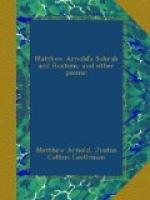“Pandion (son of Erichthonius, special ward to Minerva) had two daughters, Procne and Philomela, of whom he gave the former in marriage to Tereus, king of Thrace (or of Daulis in Phocis). This ruler, after his wife had borne him a son, Itys (or Itylus), wearied of her, plucked out her tongue by the roots to insure her silence, and, pretending that she was dead, took in marriage the other sister, Philomela. Procne, by means of a web, into which she wove her story, informed Philomela of the horrible truth. In revenge upon Tereus, the sisters killed Itylus, and served up the child as food to the father; but the gods, in indignation, transformed Procne into a swallow, Philomela into a nightingale, forever bemoaning the murdered Itylus, and Tereus into a hawk, forever pursuing the sisters.”—GAYLEY’S Classic Myths.
=4.= Use the subjoined questions in studying the poem.
=5. O wanderer from a Grecian shore.= See note, l. 27.
=8.= Note the aptness and beauty of the adjectives in this line, not one of which could be omitted without irreparable loss.
=18. Thracian wild.= Thrace was the name used
by the early Greeks for the entire region north of
Greece.
[185]
=21. The too clear web=, etc. See introductory
note to poem for explanation of this and the following
lines.
=27. Daulis.= A city of Phocis, Greece, twelve miles northeast of Delphi; the scene of the myth of Philomela. =Cephessian vale.= The valley of the Cephissus, a small stream running through Doris, Phocis, and Boeotia, into the Euboean Gulf.
=29. How thick the bursts=, etc. Compare
with the following lines from
Coleridge:—
“’Tis the merry nightingale
That crowds and hurries and precipitates
With fast, thick warble his delicious notes,
As he were fearful that an April night
Would be too short for him to utter forth
His love-chant, and disburthen his full soul
Of all its music!”
—The Nightingale.
Also
“O Nightingale! thou surely art
A creature of a ’fiery heart’:—
These notes of thine—they pierce and pierce;
Tumultuous harmony and fierce!
Thou sing’st as if the god of wine
Had helped thee to a Valentine.”
—WORDSWORTH.
=31-32. Eternal passion!
Eternal pain!= Compare:—
“Thou warblest sad
thy pity-pleading strains.”
—COLERIDGE,
To a Nightingale.
and
“Sweet
bird ...
Most musical, most melancholy!”
—MILTON,
Il Penseroso.
Image the scene in the poem. How does the author secure the proper atmosphere for the theme of the poem? Account for the note of triumph in the nightingale’s song; note of pain. What is shown by the poet’s question, ll. 10-15? What new qualities are added to the nightingale’s song, l. 25? Account for them. Why eternal passion, eternal pain? Do you feel the form of verse used (Pindaric blank) to be adapted to the theme? [186]




